HMS Anson, an Astute-class nuclear-powered submarine, has been loading Tomahawk cruise missiles while docked in Gibraltar.
Images of the loading operation were shared on social media and subsequently circulated by notable naval commentators.
Not sure if HMS Anson is being loaded with Tomahawk missiles, or Spearfish torpedoes, but it does take quite a bit of manpower to do so. #Gibraltar pic.twitter.com/EveWQPrOPI
— Ian Mackie (@1anMackie) February 5, 2025
Like her Astute-class counterparts, HMS Anson is designed for a range of critical tasks, including intelligence-gathering and strategic strike. The submarine’s Tomahawk Land Attack Missile (TLAM) capability allows it to engage targets on land at distances of around 1,000 miles with pinpoint accuracy. The Tomahawk—often referred to simply as TLAM—travels at low altitude, using a jet engine rather than a ballistic trajectory to evade detection and strike precisely.
Originally introduced into Royal Navy service in the late 1990s, Tomahawk missiles have been employed in a number of recent military operations, including conflicts in Kosovo, Afghanistan, Iraq, and Libya. In 2017, the U.S. Navy famously launched 59 Tomahawks against targets in Syria, underscoring the missile’s continued relevance. The UK most recently purchased 65 additional Tomahawks in July 2014.
HMS Anson is the fifth Astute-class submarine to enter service with the Royal Navy. Its presence in Gibraltar, coupled with its ability to load and deploy Tomahawks, highlights the strategic and flexible nature of the Astute programme—ensuring that the Royal Navy retains a credible, long-range strike option wherever its interests require.
According to Raytheon, these are the general specifications:
| Primary Function: Long-range subsonic cruise missile for striking high value or heavily defended land targets. |
| Contractor: Raytheon Missile Systems Company, Tucson, AZ. |
| Date Deployed: Block II TLAM-A IOC – 1984 Block III – IOC 1994 Block IV – IOC 2004. |
| Propulsion: Block II/III TLAM-A, C & D – Williams International F107 cruise turbo-fan engine; ARC/CSD solid-fuel booster |
| Length: 20.3 feet; with booster: 20 feet 6 inches (6.25 meters). |
| Diameter: 21 inches |
| Wingspan: 8 feet 9 inches (2.67 meters). |
| Weight: 3,330 pounds with rocket motor. |
| Speed: Subsonic – about 550 mph (880 km/h). |
| Range: Block III TLAM-C – 900 nautical miles (1000 statute miles, 1600 km) Block III TLAM-D – 700 nautical miles (800 statute miles, 1250 km Block IV TLAM-E – 900 nautical miles (1000 statute miles, 1600 km) |
| Guidance System: Block II TLAM-A – INS, TERCOM Block III TLAM-C, D Block IV TLAM-E – INS, TERCOM, DSMAC, and GPS. |
| Warhead: Block II TLAM-N – W80 nuclear warhead. Block III TLAM-C and Block IV TLAM-E – 1,000 pound class unitary warhead. Block III TLAM-D – conventional submunitions dispenser with combined effect bomblets. |
At the UK Defence Journal, we aim to deliver accurate and timely news on defence matters. We rely on the support of readers like you to maintain our independence and high-quality journalism. Please consider making a one-off donation to help us continue our work. Click here to donate. Thank you for your support!




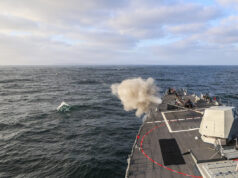
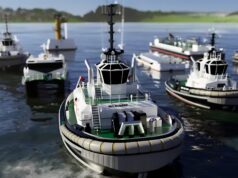

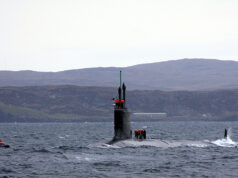
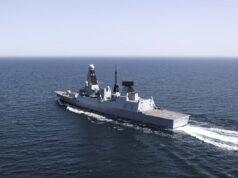

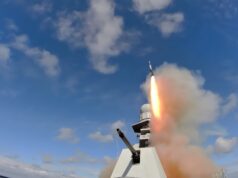
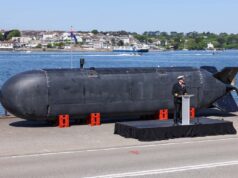


This was widely publicised a few years ago, and it was clear it was being encouraged by MoD to send a message.
Same again?
Looking forward to reading the report that HMS Glasgow and HMS Venturer have been loaded with land attack missiles.
Its worth pointing out that the Block II TLAM-N can be loaded with a nuclear warhead. No suggestion that these have been, of course
There are no Block 2 TLAM-Ns left they were all scrapped..
However, Submarine Launched Cruise Missile (Nuclear) (aka SLCM-N) is tentatively scheduled to achieve IOC in 2034, aboard Virginia class SSNs, equipped w/ VPM, and potentially, Zumwalt class DDGs. Very few specifications available in the open press, but the presumption is that it will include latest applicable tech. Eventually, essentially every USN submarine will be equipped to prosecute WW III. May be
sufficient to cause the CRINK despots to pause and contemplate consequences of planned aggression. Would anticipate RN would be offered FMS sales intended for SSN-A, or potentially co-development under auspices of AUKUS. Conceivably, all RAN SSN-A could also be equipped w/ SLCM-N, once all applicable treaties expire.
…FMS, intended…🙄
Possible but, you require a warhead designed to fit in the missile plus some suitable nuclear material being made available from very limited stocks (in the UK, at least).
Great capability, but with the number in stock being below 100 I believe, they wouldn’t last long even in a medium intensity conflict. Air defence systems operated by potentially hostile states are also much more effective than they used to be, so it is far from guaranteed that these relatively slowly and non-stealthy missiles will make it to their targets.
Part of me clings on to a faint hope that there is some secret stockpile of many more missiles, which are even more capable than we let on.
That was why a very large pile of Storm Shadow was bought.
At that time RN didn’t have a general VLS as it had T42 with Sea Dart [launcher arm] and T22/23 with Sea Wolf [bespoke VLS].
The plan was for T45 to have Mk41 VLS but it never happened.
Sub launched TLAM is a Day1 capability for surprise.
Given that 2-3 subs would be deployable and the numbers they can carry I don’t think a massive stockpile is the best use of funds.
When we have Mk41 then it is a different story. But we are likely to have the Anglo- French missile(s) by then.
Indeed that was one of the more very sensible defence moves by the last Labour government..the purchase of a serious amount of storm shadows that would make anyone pause. I believe it was around 900 missiles..essentially so the UK had an arsenal of 1000 cruise missiles 900 storm shadow and 100 tomahawks..
The UK can only have maybe 80 of these weapons left surely? several were fired off at Serbia, Iraq, Kuwait, Afghanistan, Libya and that must have reduced our stockpile down. Its high time we got replacements and also fitted the LRASM into the new Mk41 VLS’s coming soon.
From what little I have been able to read over the years our stockpile has hovered around that sort of level for most of the time. However, if memory serves the stockpile fell well below that level at one time, I think during Cameron’s Government, there was a bit of a public political spat a good few years ago now that there were not enough so we bought a few more.
No idea what the current level is but we have always topped the levels up from time to time as we do have to carry out the occasional training / test firing even when we are not using them for real.
To be honest our TLAM capability is more of a political weapon. Whilst we have on rare occasions used them independently, we have mostly used them to demonstrate our political support for the US.
Cheers CR
Really unconvinced about an aged non-stealthy and sub sonic system having much effectiveness in a peer level conflict. I do wonder if their success in low intensity warfare has created a bit of delusion that Tomahawk is a wonder weapon, a well prepared and equipped AD network would gobble these up as hinted at by the Iranian missile attacks on Israel last year.
And yet Storm Shadow, an aged sub-sonic, non-stealthy system, is reportedly highly effective in a peer a level conflict.
Although storm shadow is actually a stealthily missile it was designed shape wise and with materials to be low observable, it’s also not that old as cruise missiles go, design started really in 1995 and finished in 2003 so it’s a present generation missile and not old at all. Tomahawk on the other hand was developed from 1972 to 1981 and is not really a present generation cruise missile but a classic Cold War missile, it had zero stealth characteristics. Although both missiles fly at around 50m altitude which means a ground radar would need to be within 18 miles on flat topography to detect..any hills or raised topography would block even that…
So storm shadow is a difficult beast to find even with a look down airborne radar..small stealth object in ground clutter.
“it had zero stealth characteristics”
Not totally accurate. While all the literature on upgrades over the years have focused on warhead, seeker and propulsion, they have quietly modified/reshaped several parts of the weapon. If you look at pictures of early examples of the tomahawk, you are able to spot significant differences with the current day versions.
Curious to hear what your definition of low intensity warfare is. I’m fairly certain gulf war 1 and 2 would meet any standards for high intensity warfare against at the time one of the most dense and integrated SAM systems on the planet. You seem to also be unaware that these were also very effective in the kosovo/serbian conflict as well and I have no heard anyone except for you claim that these are not well prepared and equipped AD systems.
In both of gulf wars the AD systems would have been hit by stealth aircraft prior to launching tomahawks. Saddams AD was much weaker by the time the 2003 gulf war happened. 22 years have passed, Radar and AA missiles have evolved a lot since then, so I agree that Tomahawk is more vulnerable than used to be.
The Kosovo air campaign was a tactical failure, the Serbs executed a very successful deception campaign, a majority of their army avoided the airstrikes.
There are so much inaccuracies it’s hard to know where to start. There are several really good documents on the history of this and I suspect you are overestimating how many stealth aircraft were operating and underestimating how many cruise missiles were actually used during the opening hours of the first gulf war. “The Kosovo air campaign was a tactical failure” Again, there are a lot of knowledgeable people at different levels of this operation who disagree with this completely but that’s another discussion. Yes there are more vulnerable now but there is a reason why they are still being manufactured by the people who have all the data on how successful they really are. In the words of multiple people who have operated SAMs, there is nothing more stressing on a AD system than a small, low flying cruise missile, tlams, kalibr, exocet.etc. take your pick.
“There are so much inaccuracies it’s hard to know where to start.”
You mean you can’t point out any “inaccuracies” or counter with facts,
you just don’t like a different opinion to yours,
Unfortunately because of this new terrible posting format of this site, I can no longer respond to your reply but as I have said, there are numerous accounts from actual pilots flying F-117s that night, including the pilot that dropped the very first bomb. It’s really not hard to find if you make some effort to actual research the topic instead of posting what you “think” happened. As an aside, just basic math will give you an idea of the weapon that took out the most targets in the opening stages. The US launched 200+ tomahawks over the first two days of the war with claims of an exceptionally high success rate. How many F-117 do you think existed and was operational during that same time? With regards to the Kosovo conflict, even if it was a tactical failure which is disputed, it’s interesting that you would conflate the overall success of that campaign with the effectiveness of a specific weapon. Two completely separate things.
Even if half of TLAM get shot down, it still means half of TLAM get through & hit the target.
I remember when they disbanded ten ta infantry battalions to buy the tlam then wasted then in a single volley in Iraq to push an illegal war
I don’t recall the RN firing TLAM at Iraq?
What year was that, 2003?
Afghanistan in 2001, yes.